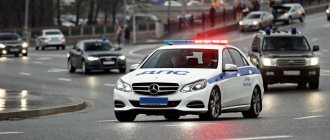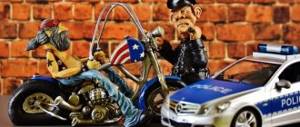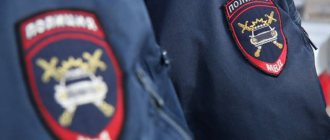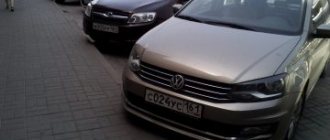Many motorists have always believed that the traffic police can stop motorists only at stationary checkpoints in accordance with Order of the Ministry of Internal Affairs No. 185. But it does not indicate where the inspector can stop the car. The Order only puts into effect the Administrative Regulations, which must be referred to on this issue. At the time of writing this review in 2021, there are no changes to this order.
The regulations may change and be adjusted. The updated version came into force in 2021, and a new Order of the Ministry of Internal Affairs No. 664 was issued for its approval. The new version of the regulations includes a condition under which it is possible to check the documents of drivers outside a stationary post. Let's figure out what reasons exist for this.
- Stop grounds
- Is the traffic police inspector required to show orientation?
- How can you stop a car?
- Procedure for checking documents
- What are they checking on foreigners?
- Conclusion
Stop grounds
The new version of the law gives the traffic police inspector the right to stop a car driver on the road not at a stationary post, but at any place in order to check documents. However, the inspector cannot choose such a place on his own; for this he needs an order from his superiors. These changes regarding stopping outside a stationary post were made due to a large reduction in traffic police posts. This, in turn, is due to the massive reduction of employees of the State Traffic Inspectorate.
In fact, inspectors were previously able to stop vehicles in any place if special events were being carried out. Therefore, the new order changed almost nothing, especially in urban areas. Inspectors will easily find the reason for the stop, and drivers usually do not argue with them. After all, it’s easier to get and show your license and compulsory motor liability insurance policy than to enter into disputes with the police, which will cost you more.
Service areas for inspectors are established by analyzing the accident rate in a given area, identifying dangerous places, difficult road conditions, and operational reports. The regulations prohibit the inspector from smoking while communicating with the driver, oblige him not to be rude, to be polite, and to refrain from discrimination of various kinds. You cannot make unlawful accusations or insult.
You can stop for the following reasons:
- Violation of traffic rules, which is recorded by technical means or visually.
- Information about the involvement of the driver or passengers in a crime or accident was received.
- There is information about the theft or search for a car.
- The driver is a witness to an accident, a crime, stopped to give evidence.
- Participation of witnesses.
- The police officers urgently needed a car.
- Prohibition or restriction of vehicle movement.
- Ensuring unhindered and safe passage for special services vehicles.
- Providing assistance by the driver to other road users or the police.
- Carrying out an event, execution according to special orders.
- Scheduled check. The car is checked for being wanted, transporting prohibited substances, or wanted people.
- Threat to traffic safety due to breakdown of technical equipment, road works, man-made accidents, natural disasters, emergencies.
- To check documents: driver’s license, for cargo transportation.
- Suspicions on the wanted list, participation of the driver in the crime.
Now there is no point by which documents could be checked at stationary posts. Therefore, the inspector can stop the vehicle to check documents anywhere. But this should happen if there is a basis for verification.
The difference between the two Orders 185 and 664 is that the grounds for the stop were previously stated. This was wrong. But the first point is that the signs of a violation, according to the inspector’s suspicions, are the testimony of witnesses and landmarks. If he received an indication on the road that a certain car was involved in a crime, then the inspector would have every reason to stop him.
Special events are also a good reason to stop at a non-static post. This applies to the following events: “sober driver”, “child safety” and others.
Reasons for stopping a car by a traffic police officer
There are a total of 14 reasons for stopping a vehicle:
VIOLATION OF TRAFFIC RULES OR ROAD SAFETY REQUIREMENTS
Firstly, stopping a car will be legal regardless of the method of recording the violation. As a rule, violations such as not fastening a seat belt, the absence of a child seat when transporting a child, driving without registration plates and other violations that cannot be recorded technically (but this is a matter of time and technological progress) are visually recorded. With the help of photo-video recording, speeding is mainly recorded. However, there are violations of traffic rules that are recorded both using photo-video recording and visually, for example, driving into the oncoming lane.
Secondly, why did the legislator give such a broad basis as a violation of road safety requirements, and not just a violation of traffic rules?
Ensuring road safety is an activity aimed at preventing the causes of road accidents and reducing the severity of their consequences (Federal Law “On Road Safety”).
This activity includes not only the adoption of standards regulating and establishing traffic rules, but also other requirements to ensure safety.
To ensure road safety, in addition to traffic rules (traffic rules), include:
- requirements for labor protection and safety requirements for the operation of vehicles (Article 20 of the Federal Law “On Road Safety”). These requirements mainly apply to drivers of special vehicles (excavators, loaders, tractors)
- requirements for the technical condition of cars (Article 16 of the Federal Law “On Road Safety”). Let's consider this requirement in more detail.
Failure to comply with the technical condition of the vehicle to the standards, rules and operating instructions will constitute a violation of road safety requirements. For example, the lack of identification marks (road train, spikes, transportation of children, deaf driver and others), malfunction of external lighting devices, the presence of tires of different sizes on one axle and others.
A complete list of faults is contained in the Basic Regulations for the admission of vehicles to operation and the responsibilities of officials to ensure road safety, approved by Resolution of the Council of Ministers - Government of the Russian Federation of October 23, 1993 No. 1090.
Therefore, a traffic police officer has the right to stop a car not only for violating traffic rules, but also if there are clear signs of a vehicle malfunction.
It is also worth noting the fact that the inspector can stop the car not only for obvious violations, but also for their signs. A sign is a sufficient condition for an event or action to belong to one or another type of violation. For example, the degree of tinting cannot be determined while the car is moving, so after stopping, the light transmittance of the glass is measured with a special device.
ORIENTATION TO THE FACE(S)
An orientation is a document that contains a description of a person or group of persons (age, height, appearance, clothing, etc.).
Joke
Is the inspector required to provide the driver with an orientation?
According to paragraph 89 of the Administrative Regulations, after stopping the car, the inspector must approach the driver, introduce himself and tell the reason for the stop. There is no obligation to present an orientation, just as the driver is not prohibited from demanding to present an orientation. This issue is not regulated by law. However, Part 7 of Art. 5 of the Federal Law “On the Police” establishes that a citizen must be familiar with documents that directly affect his rights and freedoms. But stopping a car is quite difficult to equate with restricting rights and freedoms. Therefore, the refusal to provide an orientation is as legitimate as the requirement to present it.
Other sources of data (information from the duty officer, squads, road users, visually recorded circumstances) are exclusively oral in nature and cannot be verified with documents.
VEHICLE ORIENTATION
This basis differs from the previous one in the object of the search. In the first case, these are individuals, in the second – vehicles. Orientation to the car contains available information about it (make, model, state number). The request to provide an orientation by the traffic police officer may also be refused.
DRIVER SURVEY
In this case, the driver will act as a witness (eyewitness) of an accident, administrative offense or criminal crime.
Can the driver or passengers refuse the survey? No, they can't. The obligation to testify is provided for in Part 6 of Art. 25.6 of the Code of Administrative Offenses and Part 6 of Art. 56 of the Code of Criminal Procedure, and liability for refusal to testify – Art. 17.7 Code of Administrative Offences, Art. 308 of the Criminal Code. As you can see, duty and responsibility are provided for by administrative and criminal legislation and depend on the event that occurred.
ATTRACTION AS AN WITNESS
A witness is any person who has reached the age of 18 and is not interested in the outcome of the case. The function of a witness is to visually record the performance of procedural actions by officials. However, the driver has the right to refuse to act as a witness. Liability for refusal to participate as a witness is not provided for by either administrative or criminal legislation.
USE OF THE CAR IN EMERGENCIES
Emergency cases include:
- prevention and suppression of crimes or administrative offenses
- pursuit and detention of persons suspected of committing a crime
- travel to the crime scene
- delivery of citizens to medical institutions for emergency medical care
- towing damaged vehicles from the scene of an accident
In emergency cases, a stop can be made regardless of the place and time of day (clause 6.14 of the Administrative Regulations, clause 3, clause 3, Article 28 F3 “On the Police”). For refusal to provide a vehicle, the driver may be subject to an administrative fine under Part 1 of Art. 12.25 Code of Administrative Offenses of the Russian Federation.
TRAFFIC CONTROL
The need to temporarily restrict or prohibit the movement of vehicles. In this case, the inspector acts as a regulator.
ENSURING TRAVEL FOR SENIOR OFFICIALS
The need to ensure safe and unhindered passage of special purpose vehicles.
PROVIDING ASSISTANCE FOR THE PASSAGE OF SPECIAL VEHICLES
Organization of unimpeded passage to the scene of emergency medical vehicles, as well as vehicles of operational and other emergency services involved in the liquidation of emergency incidents.
GIVING HELP
This ground is vague in its content and, in our opinion, duplicates such grounds for stopping as using a car in emergency cases, engaging as a witness, stopping to question the driver about any facts. It is difficult to imagine a situation where an inspector stops a car and asks the driver to help change a tire on a company car. Formally, there are grounds for stopping - assistance to police officers, but the driver’s obligation to provide assistance in this case is not provided for by law.
SPECIAL EVENTS
So-called raids are the implementation by the traffic police of planned activities in order to eliminate mass crime. For example, a complete check of drivers for alcohol intoxication, checking for licenses to operate taxis (Operation “Taxi Driver”).
Usually, the conduct of special events is indicated by a patrol route card, where the police officer makes the appropriate notes. As in the case of orientation, the law does not provide for the inspector’s obligation to present this card to the driver. There are usually obvious signs that a special event is taking place: blocking of the roadway, an abundance of police in bulletproof vests, “cordons” and riot police patrols.
THREAT TO ROAD SAFETY
Repair work, natural disasters, industrial (man-made) accidents, fires and other emergencies, leakage of hazardous substances.
VERIFICATION OF DOCUMENTS
This basis is used to verify documents for a vehicle and the right to drive it, and to check documents for transported cargo.
For checking documents, the legislator separately identified 4 grounds (clause 106 of the Administrative Regulations), but they are among the 14 considered.
The grounds for checking the documents required to participate in road traffic (clauses 2.1.1 and 2.2 of the Traffic Rules) are:
- identifying signs of traffic violations
- Availability of references (other data) for the driver
- availability of orientation (other data) for the vehicle
- carrying out measures to prevent road accidents and reduce the severity of their consequences (special measures)
In addition, paragraphs 107, 108, 109, 110, 111 of the Administrative Regulations provide for other grounds for checking citizens’ identity documents, various permits and licenses (certain types of transportation are subject to licensing), verification of markings (WIN), verification of state registration plates (number numbers), checking the technical condition of the car.
CHECKING DRIVER AND PASSENGER DOCUMENTS
If the driver or passenger is suspected of committing a crime or is wanted, or if there is a reason to initiate an administrative offense case against these citizens, as well as if there are other grounds for their detention.
Answer the question “Does a traffic police officer have the right to stop a vehicle without reason?” directly “yes” or “no” is not entirely correct, because:
- There are only 14 reasons to stop a car
- failure to comply with a LEGAL request of an inspector entails an administrative fine
According to the law, stopping a car without a reason is illegal. However, you need to understand that there are a lot of reasons for stopping and the inspector can only choose the appropriate one.
How can you stop a car?
To stop a car on the road, the traffic police inspector makes a special gesture. The request to stop can be made using a loudspeaker or by hand. In addition, a traffic police officer can use a disk with a red glowing signal or a rod. The inspector shows a place to stop the car. At night, the signal is given by light signals, if possible.
The inspector does not have the right to stop the car in places where this is prohibited according to the Traffic Rules. However, there are exceptions. For example, a driver was stopped to help stop a crime or cause harm to health.
Rights and responsibilities of an inspector after a stop
After the car has stopped at the request of the traffic police inspector, he is obliged to:
- Approach the driver without delay.
- Say hello, name your title, position, last name, first name, patronymic.
- When addressing the car owner, place your right hand on the headdress.
- State the reason for stopping.
- Show your driver's identification card upon request. Don't forget to write down the employee's details on the document.
- Demand to hand over documents without holding devices, remind the rights and obligations of the car owner if he is involved as a witness.
- Do not delay stopping time.
- Explain the essence of the offense, if it occurs.
In addition to his duties, the traffic police inspector has the right to ask the driver to get out of the car in the following situations:
- The driver showed signs of illness or intoxication.
- To conduct a personal search, inspection of a vehicle or cargo.
- To verify vehicle unit numbers with data in documents.
- If it is necessary for the driver to participate in providing assistance or for procedural actions.
- To eliminate a machine breakdown or cargo transportation disruption.
Knowing these rights and responsibilities of police officers, do not interfere with their implementation and do not break the law.
Where should you stop the car?
Let's consider paragraph 6.15 of the traffic rules:
6.15. Drivers and pedestrians must comply with the signals and orders of the traffic controller, even if they contradict traffic light signals, road signs or markings.
If you receive a signal from a traffic controller to stop the vehicle, then you must stop your car exactly where the traffic controller indicated . Even if stopping at the indicated place is prohibited by traffic rules.
However, in practice you have little room for maneuver. The traffic police officer only indicates the place where the driver must stop. However, you can choose a specific place (a meter to the left or a meter to the right) yourself. Therefore, when stopping your car, try to do it in such a way as to create a minimum of inconvenience to other drivers and not expose yourself and your car to the risk of an accident.
In practice, the traffic controller may not give a clear signal to stop. In this case, try to stop the car without violating traffic rules.
Procedure for checking documents
Road patrol officers can not only stop cars outside a stationary checkpoint, but also check documents. Article 106 of the Administrative Regulations establishes the grounds on which the police have the right to check documents.
- The inspector discovered a violation of the traffic rules by the driver.
- An information has been received regarding the involvement of the driver or his car in an accident, offense, crime, or search for a vehicle.
- When carrying out special actions to prevent road accidents and reduce their consequences.
The legislation also establishes what exactly an employee can check on the road.
According to Article 107 of the Administrative Regulations, the grounds for checking documents may be:
- Detection of signs of traffic violations, the reason for initiating a case for an offense.
- Signs of forgery of documents for cargo or vehicle were revealed.
- The orientation and suspicion of a person in committing a crime or offense.
- Bringing the driver as an attesting witness or witness.
They can also check the license to perform any activity on the following grounds:
- Identification of violations of standards in the field of road safety.
- Carrying out special measures to prevent accidents.
- Inspection of cargo, vehicle, and other cases related to the performance of duties of police officers.
During the inspection of documents, unit numbers, license plates, the inspector inspects them visually. But if necessary, devices are used to detect counterfeiting. Technical devices are used if there are signs of external changes in markings, falsification of documents, or discrepancies between records and information from the operational and reference services of the Ministry of Internal Affairs.
A police inspector can use special federal records and search data in his work. When checking cargo, similar procedures are carried out. But the compliance of the voucher and invoice with the transported cargo and the license card is additionally monitored. Signs of forgery are found in the documents: changes in markings, damage, abrasions, corrections.
Necessary conditions for stopping the car
In addition to these grounds, a traffic police officer must provide certain conditions when stopping a car. In other words, the inspector is prohibited from stopping the car anywhere. Let's figure it out.
Times of Day
Stopping during daylight hours
During the day, a vehicle can be stopped for any reason.
Stopping at night
In the dark and in conditions of limited visibility, the employee must have a luminous rod (a rod with reflective elements) and reflective equipment (clause 65 of the Administrative Regulations). There are no lighting requirements for the stopping area.
Stopping point
Stopping at a stationary traffic police post
What is a stationary traffic police post?
A stationary traffic police post (SPDPS) is a place equipped with special office premises, equipped with operational-technical and special means, engineering and other structures (clause 22.4 of the “Manuals on the organization of the integrated use of forces and means of the Department of Internal Affairs of the Russian Federation to ensure law and order”)
At the checkpoint, a stop can be made for any reason, as well as at any time of the day.
It is worth noting that a parked traffic police car cannot be a stationary post, because at least the car is not a special office space.
Stopping outside the area of a stationary traffic police post
Stopping at a non-static post is possible for all reasons. However, in this case, the inspector must have a video recorder on his chest, allowing him to record his actions and the actions of the driver. However, the absence of a registrar is not a reason not to obey the request of a traffic police officer.
Stopping under a prohibitory sign
Stopping on prohibited sections of the road (not to be confused with parking)
is possible only when regulating traffic and when it is necessary to use the car in emergency situations. Stopping for other reasons is prohibited.
There are no special provisions for stopping a car within the city or outside a populated area.
Let's compare the reasons for stopping with the conditions for stopping
What are they checking on foreigners?
Stateless persons or foreign drivers can be checked:
- Identity passport or other similar document.
- Migration documents, foreign visa.
- Driver license.
- Vehicle documentation, customs papers when importing a vehicle from abroad.
- Insurance policy or other document that is similar to compulsory motor liability insurance according to international rules.
- Entry documents, permits.
A foreigner who is a passenger, a pedestrian, or has no citizenship may be checked for a migration card, visa, passport, entry documents, or permits to visit the region.









